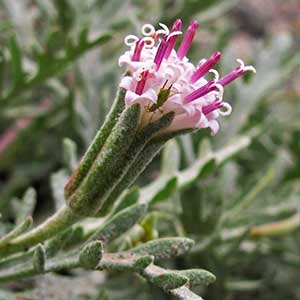Chaenactis thompsonii
Chaenactis parishii
Thompson's pincushion
Parish chaenactis, Parish's chaenactis
mostly 5–15+, ascending to erect.
mostly 5–15+, erect.
mostly cauline, 2–5 cm;
largest blades ± elliptic, ± plane, 1-pinnately lobed;
lobes mostly 2–5 pairs, remote, ± plane.
mostly cauline, (1–)2–5 cm;
largest blades lance-ovate or deltate, ± plane, 1-pinnately lobed;
lobes mostly 2–5 pairs, remote, ± plane.
ascending to erect, 2–5 cm.
ascending to erect, 2–8(–20) cm.
± obconic.
± obconic.
7–9 mm.
7–8.5 mm.
longest (10–)12–15 mm;
outer closely lanuginose, not stipitate-glandular, apices erect, ± rigid.
longest 10–13 mm;
outer predominantly arachnoid to closely lanuginose (sparsely, if at all, stipitate-glandular), apices ± squarrose, pliant.
mostly 1–3 per stem.
mostly 1–3 per stem.
7–9 mm (eglandular);
pappi: longest scales 3.5–5 mm.
4–7 mm;
pappi: longest scales 6–8 mm.
= 12.
Chaenactis thompsonii
Chaenactis parishii
Of conservation concern.
Chaenactis thompsonii appears to be sister to C. evermannii; it is known from the mountains of central and northwestern Washington. The similar habits of C. thompsonii and C. ramosa (= C. douglasii var. douglasii) appear to result from convergent evolution in the distinctive habitat of their type localities (Wenatchee Mountains), not from a close genetic relationship as suggested by Cronquist.
(Discussion copyrighted by Flora of North America; reprinted with permission.)
Of conservation concern.
Chaenactis parishii is sometimes cultivated in rock gardens. It is known from small, isolated populations in the higher Peninsular Ranges of Riverside and San Diego counties and adjacent Baja California. Chaenactis parishii and C. suffrutescens form a species pair well marked by the (usually) subshrubby habit, proximal indument persistent, white, felty, heads relatively large, and largest leaf blades lance-ovate to deltate.
(Discussion copyrighted by Flora of North America; reprinted with permission.)


